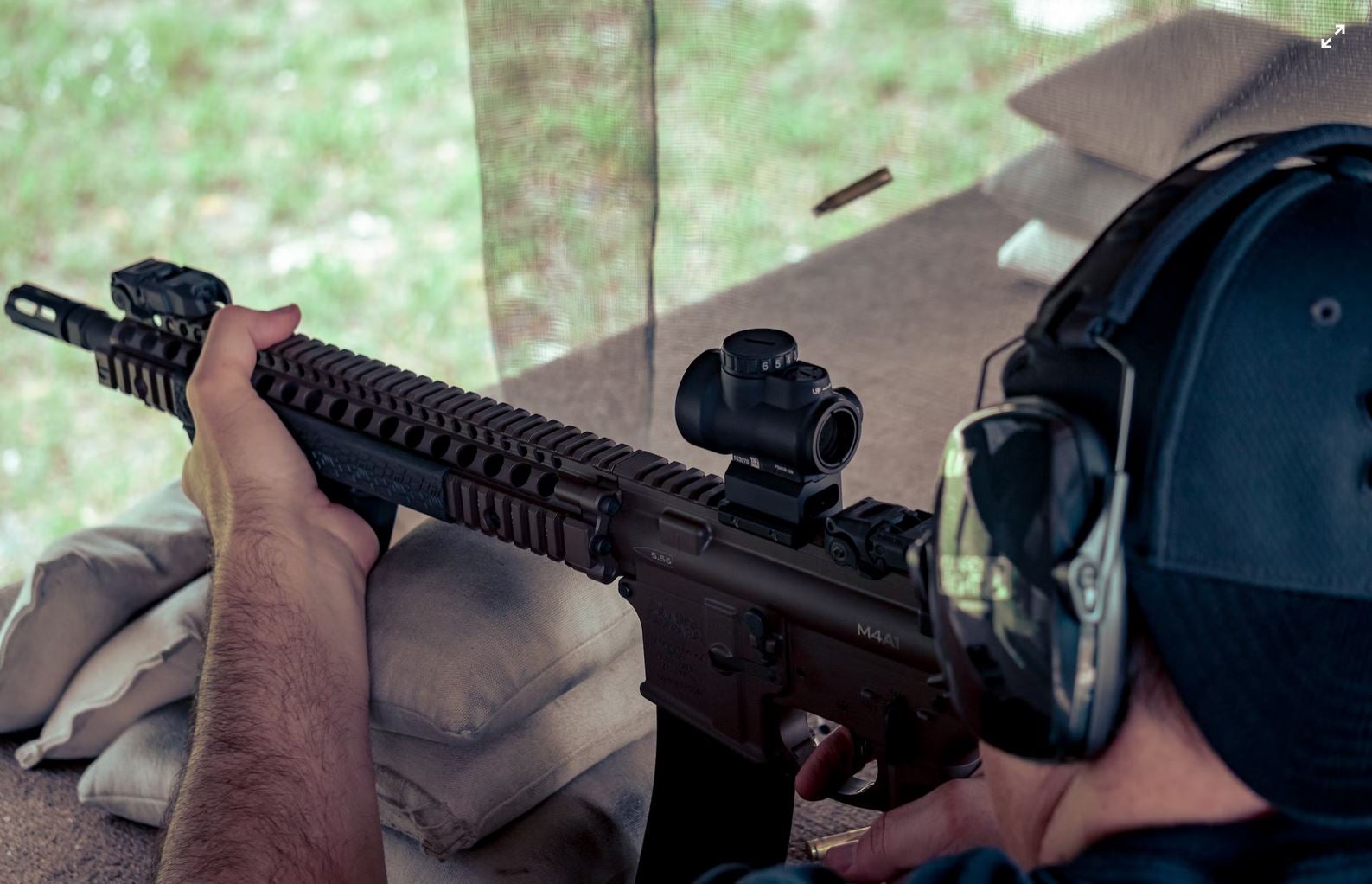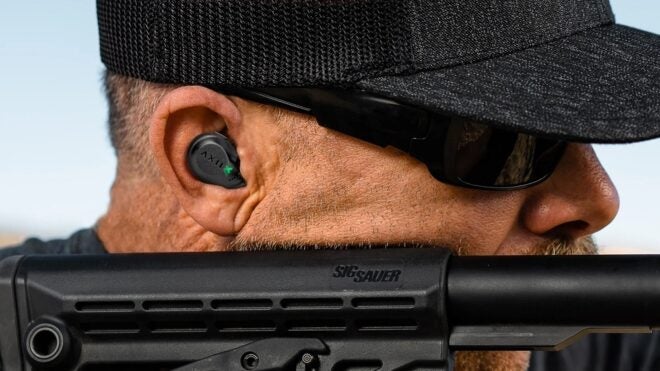Noise Reduction Ratings: How Much Shooting Ear Pro Do You Need?
Travis Olander 10.27.23

Shooting any firearm un-suppressed (yes, even that “dainty little .22” from your childhood) without ear protection will invariably cause some kind of hearing damage. Damage may be temporary, or not noticeable at first, but it will become permanent, and more noticeable as time goes on, as more live rounds exit the tube in front of your unprotected ears. You could eventually suffer Tinnitus: an insufferable, never-ending ringing in the ears that can cause depression, anxiety, and insomnia. That is why it is so important to understand noise reduction ratings for hearing protection to adequately protect yourself.
Hearing Protection Coverage on AllOutdoor
- New from Walker: Razor Tacti-Grip Series Electronic Ear Protection
- Review: Etymotic GunSport Pro Electronic Ear Protection
- AllOutdoor Review: Axil GS Digital (Ghost Stryke) Earbuds
- AllOutdoor Review: AXIL TRACKR BLU Electronic Earmuffs
If you want to protect yourself from hearing loss, you must wear hearing protection every time you shoot. It’s best to wear it even if you’re only firing suppressed rimfire ammo. But how much ear pro is needed? How do you know if you’ve bought the right amount of protection? To answer these questions, we need to understand how sound energy works – and, more importantly, how it’s mitigated by the available shooting muffs and ear plugs we often wear.
Sound Energy is Logarithmic
In simple terms, this means that as sound becomes louder to us by a certain percentage, the energy it imparts upon our ear drums – the actual mechanism of hearing injury itself – increases by a far greater amount. Unfortunately, the Decibel Scale we all think we know about does a poor job representing the dangers of sound. You’ve probably seen a noise level chart measuring decibels. It’ll example different sounds, like the typical loudness of a car exhaust, and the loudness of a jet engine. The exhaust might measure 80 decibels, while the jet engine may measure, say, 160 decibels. Conventional logic may trick you into thinking the jet engine is twice as loud – and that may seem true in the context of perceived volume. But it’s not loudness, or volume, that damages our hearing. It’s the energy of the sound waves producing that volume.
An Increase in 10 dB = 10x The Sound Energy
Our ears actually do a pretty terrible job of gauging the amplitude of sound energy. This is reinforced by the fact that most of the audio equipment we use measures sound using a simple number scale. Like the radio in your car, or the volume buttons on your phone: Turn it from 10 to 20, and you generally perceive the music gets somewhere between 50% and 100% louder. But the energy being imparted on your ears with that increase in volume, or loudness, is actually much greater.
Back to the example above: That 160-dB jet engine might seem twice as loud as an 80-dB car exhaust, but it’s actually closer to 80 times more powerful. That’s because for every 10-decibel increase in perceived volume, sound energy increases by ten times that amount. The sound energy produced by gunfire is no different. For context, any sound measuring 120 dB or greater can cause immediate hearing loss. It’s best to keep your exposure to any sound below 90 dB for an extended period of time.
The typical sound energy of gunfire starts at 140 dB, which is that of a typical .22 LR, and can climb to over 170 dB for centerfire rifle cartridges and magnum handgun loads. Arguably the most popular rifle cartridge on earth, the 5.56 NATO reports about 165 dB of sound energy next to the shooter’s ears.
What does this mean for hearing protection? We need to reduce our exposure to the sound energy of gunfire by at least five hundred times – from 140 dB (or more) to, ideally, 90 dB or below. We need some serious hearing protection. In other words, shoving some cotton balls in our ears won’t do. Thankfully, ear pro is measured by decibel reduction, also called Noise Reduction Ratings. But those advertised numbers don’t always add up to the level of protection you think you need.
Noise Reduction Ratings Explained
Noise Reduction Ratings seem pretty simple at a glance: The higher the number, the greater the reduction in sound energy. Because hearing protection is mandated by plenty of employers for job safety, noise Reduction Ratings are tightly controlled and tested by the American National Standards Institute (ANSI, which also certifies ballistic eyewear) and OSHA.
That means hearing protection manufacturers can’t just slap an NRR rating on some ear muffs and lie to you – but, because of stringent, real-world testing performed by these agencies, the actual noise-reduction ratings of most ear pro is lower than the advertised value.
NRR vs. Actual Decibel Reduction
With perfect fitment and conditions, noise reduction ratings would translate one-to-one to actual sound energy (decibel) reduction. But that’s never the case. OSHA generally recommends you subtract a value of 7 from the advertised NRRs of any hearing protection devices to find the actual noise reduction value. For example, a pair of shooting ear plugs that advertise 30 decibels’ worth of NRR would, in fact, provide a noise reduction of about 23 dB.
“How much Noise Reduction Do I Actually Need?”
With constant exposure to sound, you should aim for never exceeding 90 dB. But gunfire is intermittent and its sound waves travel quickly, which means exposure per shot is limited to a fraction of a section. So, you should generally aim to keep things below 120 dB. Most hearing protection devices will provide between 20 and 30 dB of advertised noise reduction, which means a real-world protection rating of 13 to 23 dB. Given that the sound energy of most gunfire registers between 140 and 170 dB, you’ll want a total noise reduction of 20 to 50 dB.
(You’ll Probably Need to Double Up)
To achieve this much noise reduction – especially for larger, supersonic calibers – you’ll likely need to wear both ear plugs and shooting muffs. Doubling up on hearing protection will typically eliminate your ability to hear normal noise, though, like human voices and ambient sounds.
For that reason, it’s a good idea to invest in active hearing protection. Active ear pro uses microphones to pass sound through the plugs or muffs to the ears, allowing you to clearly hear what’s going on around you. Only when it registers unsafe sound does the ear pro turn off the microphones to prevent hearing damage. Check out our review of AXIL’s XCOR Digital Ear Pro Buds. These shooting ear plugs provide active hearing protection, and even amplify voices and safe sounds, ensuring you can double up on hearing protection without losing situational awareness!

